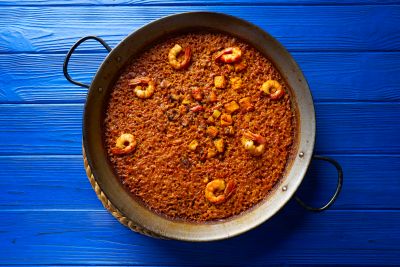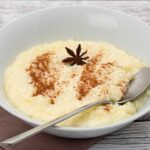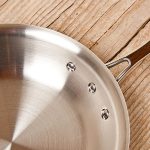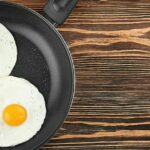If you love this most recognized Spanish dish you need to have an appropriate piece of cookware in your kitchen. If you want to make a truly delicious paella you must use a pan that is designed to do the job efficiently. This famous rice dish is traditionally cooked outdoors over an open fire and served directly from the pan. Serving the paella to your guests right from the pan make the dish look more authentic and adds a special touch to friends and family gathering.
A traditional paella pan has a wide and shallow cooking area, sloping sides, and two curved handles for easy manipulation during cooking and transport to the table. Some paella pans have a dimpled interior that traps small amounts of liquid and helps cook evenly.
The large cooking area allows the rice to be spread in a thin layer to encourage evaporation and develop a golden caramelized crust. To serve a larger group of people, you need a pan larger in diameter because the rice layer should only be 1/2″ thick. You also need to provide an adequate heat source that should fit the size of the pan. When a large pan is positioned over a single burner you must rotate the base to control the distribution of the heat.

The traditional pan for paella is slightly rounded by design which is more noticeable when you use the pan on an induction or ceramic cooktop than on a gas stove. For an induction cooktop, you need a pan with a completely flat bottom, to make contact with the cooktop surface for even cooking. Also, be aware that on ceramic/glass cooktops you can’t rotate the pan while cooking because of the delicate cooktop surface.
Even heating is essential to prevent burning and make truly delicious paella. It is important to choose a pan made from a thin material that offers a quick and uniform heating performance, and therefore good control over the cooking process.
1. Carbon Steel Paella Pan
Carbon steel is the most traditional and the best cooking surface for paella. This material has a manageable weight and heats up quickly and evenly. The tin base quickly responds to heat change, reducing the risk of overcooking. Some people believe that a carbon steel pan itself helps develop a more intense flavor.
A carbon steel pan is suitable for all types of heating sources including electric, glass, gas, oven, and open fire. It performs extremely well when used over a paella burner. When using a carbon steel pan on ceramic/glass cooktops, make sure to keep the bottom of the pan clean and never drag the pan across the surface. Carbon steel paella pans with a perfectly flat bottom are compatible with induction cooktops, while those with a slight angle are not suitable for induction cooktops or flat electric stovetops. To avoid uneven thermal expansion and warping of the pan on an induction hob, begin with low or medium heat for half a minute, then move to higher temperatures.
Unlike enameled or non-stick paella pans, you can use a metal spatula and other metal utensils to serve the meal right from the pan.
The drawback is that a carbon steel pan requires special care, such as initial preparation, hand washing, and regular seasoning.
Carbon steel pans should be hand-washed only, as they will rust if you place them in the dishwasher. Before the first use, you need to boil water in the pan and use a nylon sponge and mild soap to remove label glue and other manufacturing residues. After rinsing and thoroughly drying the pan, pour a few drops of vegetable oil and use a paper towel to coat the inside and outside surfaces of the pan. Bake the pan in the oven for about 30 minutes to complete the seasoning.
To clean the pan after use, scrub off any food residue and hold it under boiling water. If there is burnt rice on the bottom, fill the pan with water and let it sit for a while. Wash with a soft nylon pad and hot water, rinse well, and dry immediately. Never use harsh detergents or abrasive scrapers as they can remove some of the seasonings from the cooking surface.
Never leave a carbon steel pan to air dry or store it without re-seasoning as it will rust if left wet. You must dry it immediately after washing it. Heat the pan to dry all water out, pure some vegetable oil in, and allow the oil to heat for about 3-5 minutes. Allow the pan to cool, then use a paper towel to coat the pan with oil. Store the pan in a dry place.
Coating the pan with vegetable oil should prevent oxidation from starting. If rusting occurs, remove it as soon as the rust forms. Use commercial rust removers to dissolve rust and remove it using a steel wool pad. Re-season the pan after washing and drying it thoroughly, then bake it in the oven for one hour.
Using the pan helps season it, so it will cook better and it will also become nonstick with use. The pan will gradually discolor as it seasons.
Related product: Garcima 20-Inch Carbon Steel Paella Pan, 50cm
2. Stainless Steel Pan for Paella
Stainless steel pans for paella are sturdy, attractive, and require just basic maintenance. They do not need to be oiled between uses. Most brands are also dishwasher-safe.
The drawback is that stainless steel is less heat-conductive than carbon steel. The exception is an All-clad paella pan that has a heat-responsive aluminum core which ensures fast and even heating.
Some stainless-steel pans are induction-compatible. You need to read descriptions or do a magnet test to make sure that your pan is induction-ready.
Related product: Mauviel M’Elite Stainless Steel Paella pan, 15.7,
3. Cast Iron Paella Pan
Cast iron is suitable for all cookers, however, care must be taken when used on a glass cooktop as cast iron is very heavy and if dropped it may break the glass.
Cast iron construction ensures even heat distribution which is a plus, but an exceptional heat retention capability of cast iron is not an advantage when it comes to cooking paella. Too much residual heat can result in overcooking. Since the pan retains heat longer than carbon steel, you must remove it from the heat source a few minutes before the meal is completely cooked.
4. Enameled Pan for Paella
This pan is made of carbon steel or cast iron core that has been coated with an enamel finish. The enamel coating protects the surface from rust and offers a basic non-stick feature. Enameled paella pan cleans up nicely and will not rust, so you don’t have to season it.
The downside is that the enameled pan is fragile, and the coating can be damaged due to manipulation during cooking and handling. Some high-end enameled paella pans, such as Le Creuset are fairly durable and resistant to chipping, but the thick cast iron base retains more heat than is useful for the cooking process.
You need nylon, silicone, or bamboo/wooden utensils to serve the dish from an enamel-coated pan.
5. Non-Stick Paella Pan
A non-stick pan offers the convenience of easy cleaning, but it is not suitable for cooking a truly delicious paella dish. A non-stick interior doesn’t allow the rice to stick to the bottom, so you cannot get this very thin layer of caramelized rice known as socarrat, which is the core of the authentic paella dish. You also cannot use a metal utensil to scrap the rise or serve paella from a stick resident pan.
Related product: MAGEFESA Prisma – 13.4 inches Paella pan




ceramic enamelled pans contain lead
https://tamararubin.com/category/ceramcor/
The picture above here shows a Carbon Steel Paella Pan with red side handles – perfect for use in a hot oven. How much is this pan and where can I purchase it. I live in Montclair, Durban KZN. South Africa
This paella pan is available for purchase on Amazon, but the shipping costs to your location may be very high, I am afraid.